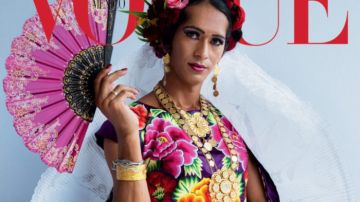Vogue Makes History with Indigenous Trans Woman on Cover
For the first time in its more than 100 years in publication, Vogue México featured an Indigenous muxe on its cover with Estrella Vázquez, a 37-year-old indigenous Zapotec muxe dressed in a traditional huipil for their December issue

Photo: Instagram/VogueMexico
For the first time in its more than 100 years in publication, Vogue México featured an Indigenous muxe on its cover with Estrella Vázquez, a 37-year-old indigenous Zapotec muxe dressed in a traditional huipil for their December issue.”Muxe” is a term associated with trans women or gender-nonconforming derived from the word “mujer” and Juchitán, Oaxaca where Vázquez is a member of one — if not the — largest muxe community.
The cover star had never hear of Vogue before she and other muxes were approached by the magazine for the photo shoot for their issue on Oaxaca’s indigenous cultures. “Everyone is seeing this cover, everyone is congratulating me. I don’t know; it’s just hard to make sense of the emotions I’m feeling. It almost makes me want to cry,” Vázquez told Reuters.
Muxes are respected craft makers in their community working as artists and merchants and are celebrated throughout Juchitán for their trans identity. Oaxaca’s three-day festival called Vela de las Intrepidas (Vigil of the Intrepids) is in honor of muxe. However, they still face discrimination and hate in a country that’s historically machista and anti-gay/trans with Catholic beliefs still popular and reinforced.
“I think it’s a huge step,” Vázquez told Reuters. “There’s still discrimination, but it’s not as much now and you don’t see it like you once did,” she said.
Vogue also interviewed Pedro Enrique Godínez Gutiérrez who recounted the violence her community has faced in Juchitán recently. “Although I live in a place that is more open to this life, I had to deal with bullying and many school complaints, so many that my mom used to say that she was at the school more than I was,” she said. “Dear, as of now we’ve got nine cases of hate crimes [in Juchitán]. We’ve even gone to Oaxaca city to make demands for justice, because there have been terrible acts committed [against muxes}.”
Muxes have a history as caregivers to aging parents, a role that has given them prestige in the face of a male-dominated culture that abides by societal expectations of gender roles. They also played a major role in the aftermath of a massive 8.1 magnitude earthquake that struck Juchitan in 2017 that led to 17 deaths in the area, as they helped dig out families in the rubble, Reuters reports.
These past couple of years the iconic fashion magazine has been recognizing indigenous women from Roma actress Yalitza Aparicio — the first indigenous woman to be on the cover — to their 20th-anniversary issue this year featuring three cover with indigenous women from Latin America.
“When I travel through Latin America, I am always asked what Vogue is doing to open the way for women to workspaces and prevent sexist stereotypes,” Karla Martínez de Salas, Editorial Director of Vogue México y Latinoamérica, writes in the magazine. “I hope that the stories we present in this anniversary edition inspire women to dream big, to start with small changes and, above all, to connect with their roots, accepting their unique beauty and celebrating their originality.”

















